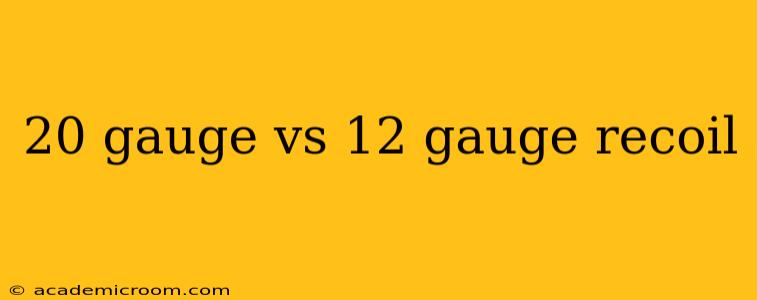Choosing between a 20-gauge and a 12-gauge shotgun often hinges on recoil management. While both are popular choices for hunting and sport shooting, their substantial difference in recoil significantly impacts shooter comfort and accuracy, especially for beginners or those with less upper body strength. This detailed comparison explores the recoil characteristics of each gauge and helps you determine which is the better fit for you.
What Causes Recoil in Shotguns?
Before diving into the 20 gauge vs. 12 gauge recoil debate, understanding the physics of recoil is crucial. Recoil is the backward force exerted on the gun when the shot charge is propelled forward. Several factors influence the amount of recoil experienced:
- Gauge: The lower the gauge number (e.g., 12 gauge), the larger the bore diameter and the heavier the shot charge, resulting in more recoil.
- Shell Load: Heavier shot loads and faster-burning powders contribute to increased recoil. A light target load will have considerably less recoil than a magnum hunting load.
- Gun Weight: Heavier shotguns absorb more recoil energy, reducing felt recoil.
- Stock Design: The shape and material of the stock influence how recoil is transferred to the shooter's shoulder. A recoil pad can significantly mitigate the impact.
20 Gauge Recoil: Lighter, Gentler, but Less Powerful
The 20 gauge is known for its significantly reduced recoil compared to the 12 gauge. This makes it a more comfortable option for smaller-statured shooters, younger individuals, or anyone sensitive to recoil. The lighter shot charge results in less force pushing back against the shooter.
Advantages of 20 Gauge:
- Reduced Recoil: The primary benefit is the noticeably lighter recoil, leading to improved comfort and faster follow-up shots.
- Lighter Weight: 20-gauge shotguns are typically lighter than their 12-gauge counterparts, making them easier to carry and handle for extended periods.
- Suitable for Smaller Shooters: The lower recoil makes it an excellent choice for introducing younger shooters or individuals with less upper body strength to shotgun shooting.
12 Gauge Recoil: Powerful, but with a Kick
The 12 gauge is the workhorse of the shotgun world, renowned for its power and versatility. However, this power comes at a cost: significantly more recoil than a 20 gauge. This stronger recoil can be fatiguing for extended shooting sessions and may deter beginners.
Advantages of 12 Gauge:
- More Powerful: The heavier shot charge delivers greater stopping power, making it ideal for hunting larger game.
- Wider Range of Ammunition: The 12 gauge boasts a broader selection of ammunition types, including specialized loads for various applications.
- Greater Availability: Finding 12-gauge ammunition is generally easier than finding 20-gauge shells.
Which Gauge is Right for You?
The "best" gauge ultimately depends on individual needs and preferences. Consider the following:
- Your Physical Build and Strength: If you're smaller or have less upper body strength, the reduced recoil of the 20 gauge is generally preferable.
- Intended Use: For hunting larger game, the power of the 12 gauge might be necessary. For smaller game or sporting clays, the 20 gauge is often sufficient.
- Shooting Experience: Beginners often benefit from the gentler recoil of the 20 gauge to develop proper shooting form and build confidence.
- Ammunition Availability: Consider the availability of ammunition in your area.
How to Reduce Recoil in Both Gauges
Regardless of the gauge you choose, several techniques and accessories can help minimize felt recoil:
- Recoil Pad: A good recoil pad significantly softens the impact.
- Proper Shooting Stance: Maintaining a firm grip and proper posture helps absorb recoil.
- Shoulder Placement: Ensure the stock fits your shoulder properly to distribute the recoil force effectively.
- Lighter Loads: Choose lower-recoil ammunition, such as light target loads.
What are the Different Types of 20 Gauge Shells?
20 gauge shells come in a variety of loads, similar to 12 gauge. These include target loads for sport shooting, field loads for hunting smaller game, and even some heavier loads for larger game, though these are less common than in 12 gauge. The difference in recoil between these loads within the 20 gauge is still significantly less than the difference between a 20 gauge and a 12 gauge of similar purpose.
What about the 28 Gauge and .410 Bore?
While less common than 12 and 20 gauge, the 28 gauge and .410 bore offer even lighter recoil options, but with a significant trade-off in power. They are best suited for very small game or target shooting at close range.
Conclusion: Choosing the Right Gauge for Your Needs
The choice between a 20 gauge and a 12 gauge comes down to a balance between power and recoil. While the 12 gauge offers superior power and a wider selection of ammunition, the 20 gauge provides a significantly more comfortable shooting experience with less recoil. Carefully consider your physical capabilities, intended use, and shooting experience to select the best gauge for your specific needs.
